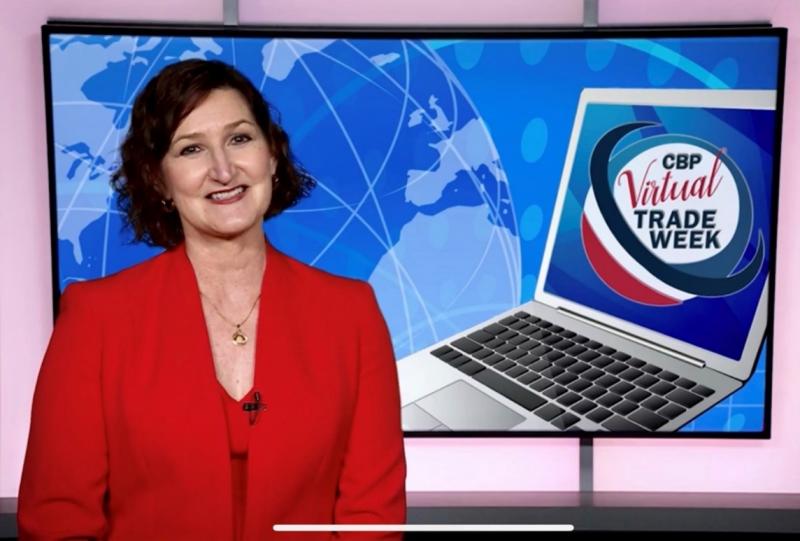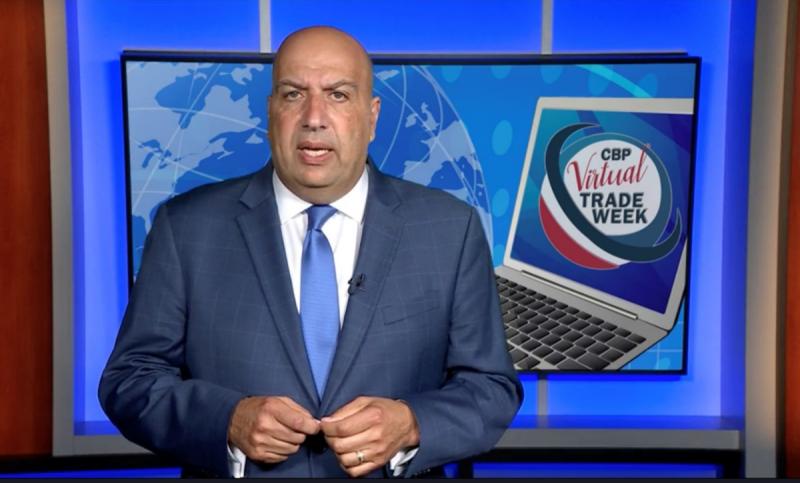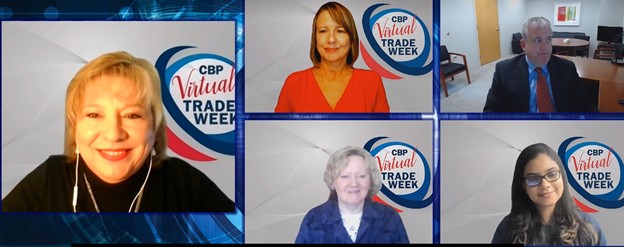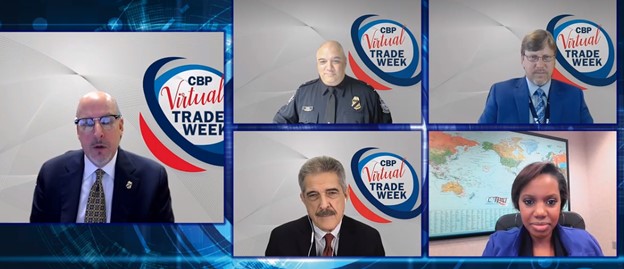
attendees to CBP’s second Virtual Trade Week,
held July 20-22.
Photo Credit: U.S. Customs and Border Protection
As America continues to recover from the COVID-19 pandemic, U.S. Customs and Border Protection hosted its second Virtual Trade Week, July 20-22, bringing its industry and government partners together. The three-day event, which drew nearly 3,000 registered attendees, emphasized strengthening America’s economic growth through partnerships.
“As we collectively exhale from 2020 and the COVID-19 pandemic, I think it’s important to take stock of everything we’ve been through,” said CBP Acting Commissioner Troy A. Miller in his welcoming address. “We’ve seen a lot of change in our country in the last year and a half, and plenty of change has come to CBP as well. We had to adapt the way we did business, evidenced here this week, as we launch the second ever Virtual Trade Week. We had to be flexible and find innovative solutions. We worked incredibly hard to keep both our workforce and the traveling public safe,” said Miller. “Your partnership and collaboration throughout the pandemic were critical for CBP, and helped keep the nation’s economic engines running.”
Miller noted that the leadership of CBP’s Office of Trade also has changed. AnnMarie Highsmith, a 29-year veteran of CBP who served the last eight years as the agency’s deputy chief counsel, was appointed the new executive assistant commissioner of the Office of Trade.

Commissioner of the Office of Trade AnnMarie Highsmith
spoke about the current trade landscape and CBP’s vision
for the future in her keynote address on July 21, at CBP’s
second Virtual Trade Week.
Photo Credit: U.S. Customs and Border Protection
On the second day of the event, Highsmith spoke to attendees about how critically important the agency’s partnerships are, especially as we emerge into a changed world. “We are operating in a trade environment that is ever-shifting and evolving. It is crucial to the economic security of this country that we keep up with and anticipate changes, and form implementable solutions that will make trade faster, more sustainable, transparent, and secure to the benefit of us all,” said Highsmith. “Much of our work relies implicitly on our partnerships,” she continued. “We are all invested in the future of trade, and every aspect of our mission could benefit from working together with the trade community.”
One example that Highsmith discussed was the 21st Century Customs Framework. “The 21st Century Customs Framework is an initiative that exists to meet the challenges of 21st century trade, and allows us to play a role together in determining what trade looks like for the next era,” said Highsmith, explaining that collaboration with CBP’s public and private sector partners is the foundation of the initiative, which was launched in March 2019, at a public meeting that included extensive input from both government partners and the trade community. “The Framework offers a paradigm for the evolution of trade in the 21st century and calls for a long overdue modernization of customs policy, regulatory, and statutory changes that will strengthen our trade mission well into the future,” said Highsmith.

Office of Field Operations William Ferrara spoke about
the impact the COVID-19 pandemic has had on the
agency in his keynote address on July 22, at CBP’s
second Virtual Trade Week.
Photo Credit: U.S. Customs and Border Protection
Other speakers from CBP’s top brass included Executive Assistant Commissioner of Field Operations William Ferrara, who spoke about the impact COVID-19 has had on the agency. “Like all of you, the pandemic has taken a toll on us. Our day-to-day duties are already challenging and the pandemic magnified a lot of our daily stressors,” said Ferrara, who expressed pride in the dedication of his workforce. “Despite the pandemic and all of the challenges these individuals endured, they stepped up to the plate and ensured that our national security mission never faltered and our important essential trade mission continued.”
Ferrara asked the audience to take a moment to remember the 35 CBP employees who tragically lost their lives to COVID while in the line of duty. “In the Office of Field Operations, we lost 21 of those line of duty deaths,” said Ferrara. “The courage, bravery, and commitment of our fallen inspire us each day, and we will never forget those who paid the ultimate sacrifice.”
In terms of trade, Ferrara shared that at the beginning of the pandemic, CBP saw a decline in shipments, but the volume is rebounding. “We are currently processing a six percent increase from pre-pandemic levels in commercial trucks,” he said. “As the economy continues to re-open, our partnerships with the trade community are vital.”
John Leonard, the newly appointed deputy executive assistant commissioner for CBP’s Office of Trade, informed the virtual audience about the high number of counterfeit COVID-related goods that have been seized. “With the support of partner government agencies, CBP has seized tens of millions of unsafe, substandard, and counterfeit personal protective equipment shipped to the United States by those seeking to make a profit off of the pandemic,” said Leonard. “As of June 30, 2021, CBP has seized almost 190,000 fake, ineffective COVID-19 antibody test kits; 40 million counterfeit N95 face masks; over 45,000 medications including chloroquine, hydroxychloroquine, and erythromycin; and just under 450,000 hand sanitizers. Had these goods been able to enter the country, they would have posed serious health and safety risks to consumers,” he said, noting that these counterfeit items were in addition to the thousands of other counterfeit products that CBP seizes daily. Moreover, Leonard added, “with the help of public and private partnerships, CBP was able to facilitate legitimate and compliant personal protective equipment that healthcare facilities and frontline workers needed to save lives.”
The agenda also featured notable speakers such as Congressman Earl Blumenauer, Chairman of the House Ways and Means Trade Subcommittee, and Department of Homeland Security Deputy Secretary John Tien, who shared his thoughts about private sector engagement. “We have forums like Virtual Trade Week, which are key for DHS and CBP to solidify our partnerships with compliant companies. Because when government and industry work together, all of us succeed in keeping our economy strong and protecting our country from unsafe goods and illegal trade practices,” said Tien. “We rely on public-private cooperation to improve our work, so we’re constantly drawing on the knowledge and wisdom of not only government experts, but importers, carriers, customs brokers, manufacturers, and more.”
Cass Sunstein, the top regulatory officer at DHS, also gave keynote remarks. Sunstein appealed to the trade community to participate in the Department’s regulatory reform. “With respect to trade, DHS is really interested in modernizing its existing rules and requirements,” said Sunstein, senior counselor to the secretary of Homeland Security for regulations and the DHS regulatory policy officer. “We need your help to remove outdated regulations, address new threats, and review existing and draft regulations to maintain security while meeting the President’s goals of free and fair trade.”

and law enforcement, left, led a panel on forced labor at
CBP’s second Virtual Trade Week. Panelists include,
clockwise, Therese Randazzo, director of CBP’s forced labor
division; Matt Murray, deputy assistant secretary for trade policy
and negotiations, State Department’s Bureau of Economic
and Business Affairs; Anasuya Syam, human rights and trade
policy advisor, Human Trafficking Legal Center; Julia Hughes,
president, United States Fashion Industry Association.
Photo Credit: U.S. Customs and Border Protection
Among the many panel discussions presented throughout the week was a session on the 21st Century Customs Framework initiative, the most significant U.S. trade modernization effort since the Customs Modernization Act in 1993. As part of the discussion, panelists compared the trade landscape of today versus 28 years ago. One of the most striking differences back then was the lack of partnership. “I would describe the relationship between Customs and the business community as distrust,” said panelist George Weise, who was the commissioner of the U.S. Customs Service, one of CBP’s legacy agencies, when the “Mod Act” was passed.
Weise shared that 50 years ago, when he began his career as an import specialist with the U.S. Customs Service, the motto was “protect the revenue.” “The way people got promoted in that environment was what I call ‘gotchas.’ If we could catch a business in noncompliance, we would get ahead and get promoted because we were doing our job and increasing the country’s revenue,” said Weise.
The Mod Act changed that. “The most important concept in the Mod Act is informed compliance. No more gotchas from Customs. No more getting credit for catching people in noncompliance. We were measured by the level of compliance we achieved working with the business community,” explained Weise. “Informed compliance meant Customs has a responsibility to educate the business community on what was expected of them. And then, the business community had a responsibility to exercise reasonable care to do the best job they could to be in compliance. Together, we worked to achieve a high level of compliance,” said Weise. “I think that’s been working very well for a long, long time.”
Garrett Wright, the director of CBP’s Trade Modernization Office, offered his perspective. “What strikes me is how fundamentally similar today’s challenges are to the challenges that drove the Mod Act. The Mod Act was born out of the need to move away from paper-based trade towards electronic trade. Because at the time, with trade volumes growing as they were, we needed to figure out a way to process and move trade along more efficiently. Electronic trade was the answer to that as was shared responsibility with industry. Electronic trade is something that government and industry are still trying to fully embrace today,” said Wright.
Similarly, the impact of growing trade volumes compounded by CBP’s evolving trade mission are still major challenges for the agency, explained Wright. “Just to give the audience a flavor of what I’m talking about, last year, in fiscal year 2020, the agency processed 694 million shipments in our postal express and air cargo environments. Think of that,” said Wright. “That’s nearly two million small packages a day that we’re processing. In fiscal year 2013, that number was 235 million. So in the span of seven years, small package volumes have nearly tripled, and consequently so has the agency’s mission,” he said. “Because many of those small packages enter our stream of commerce every day, and many of them contain counterfeit merchandise, and in some cases, unsafe, dangerous products that cheat right holders out of their intellectual property, undercut domestic businesses, and put American consumers at risk.”
Wright added that “as trade volumes continue to grow, so does the agency’s workload and responsibility in facilitating the safe and efficient flow of legitimate trade. The problem,” he said, “is our underlying legal authorities are 28 years old or older at this point, and in many ways do not reflect today and tomorrow’s trade environment. Our law makers likely did not predict the explosion of e-commerce.” Nor did they “likely predict that China would eventually become our No. 1 importer and what that would mean for U.S. interests and economic security. So to bring it back around, there are a lot of similarities between what drove the Mod Act and what’s driving the 21st Century Customs Framework today. Some difference too, but I think fundamentally, both are grounded in the need to modernize for the benefit of the U.S. and our collective interests and equities.”
Another panel discussion focused on forced labor. Panelists shared their perspectives on the pervasive scale and scope of the highly complex issue, how it has evolved, and ways to combat the crime. “Forced labor is rampant in global supply chains,” said panelist Anasuya Syam, the human rights and trade policy advisor for the Human Trafficking Legal Center, a non-governmental organization dedicated to combatting forced labor worldwide. “There exists a very concerning and often cited statistic that more than 25 million people are held in conditions of forced labor around the globe. These are low estimates from 2017. We know that the conditions have only worsened.”
Syam identified policies to deter forced labor in supply chains. Trade sanctions and increased enforcement were two of them. “Thirty-one withhold release orders and counting issued by CBP since 2016 has been encouraging,” said Syam, explaining that “the risk of suffering financial, reputational, and legal harm that can come during or in the aftermath of a CBP forced labor investigation,” can be crippling for companies. “Forced labor enforcement has consequences for not just foreign producers, but also for U.S. importers,” Syam continued. “Just last year, CBP enforced its first civil fine on a U.S. importer for importing the artificial sweetener Stevia, manufactured using prison labor in China. That, in fact, is now a staple in the non-governmental organization tool kit to curb forced labor and hold perpetrators accountable.”
Syam also told the audience that the Human Trafficking Legal Center published a practice guide to assist companies that suspect forced labor within their supply chains. “This guide includes a suggested template for making forced labor allegations to CBP,” she said.
However, Syam cautioned, “the United States cannot fight this battle alone, and should work closely with its allies to ensure that forced labor is stamped out from global supply chains. Ultimately, no country should serve as a safe harbor for these tainted products.”
Panelist Julia Hughes, the president of the United States Fashion Industry Association, discussed how fashion companies manage supply chains that span the globe. “Because we are a global industry and we know that forced labor exists in many parts of the world, for several decades, fashion brands and retailers have maintained codes of conduct and strict requirements for supply chain partners that ban the use of forced labor,” said Hughes. “Companies maintain an extensive network of contracts, audits, verifications, training, and direct engagement with suppliers.”

and conveyance security, left, moderated a panel discussion
on the Customs Trade Partnership Against Terrorism, or
CTPAT, at CBP’s second Virtual Trade Week. Panelists include,
clockwise, Manuel Garza, CBP’s director of CTPAT; Jeff Gifford,
director of border security and asset protection for Magna
International; Carmen Perez, CBP CTPAT trade compliance
branch chief; Fermin Cuza, president of the World BASC
Organization. Photo Credit: U.S. Customs and Border Protection
“So what do we need from government?” asked Hughes. “We need and want whole of government strategies to eliminate forced labor. We also want to continue to expand the U.S. leadership role on the international stage,” said Hughes. “Forced labor is a global problem and requires a global solution with the U.S., our allies, and international organizations working together.”
One government strategy that has helped is CBP’s close collaboration with the State Department, said Deputy Assistant Secretary for Trade Policy and Negotiations Matt Murray. “The law prohibiting imports made with forced labor has been on the books since 1930, but it’s only been in the last few years as part of the Trade Facilitation and Trade Enforcement Act that more activity has been taking place. Since 2016, CBP has greatly increased its efforts to ensure that goods mined, manufactured, or produced with forced labor wholly or in part do not enter U.S. commerce,” said Murray. “That requires some explanation and work with our trading partners overseas so that they understand CBP’s authorities and the reason behind this new energy and focus. This has given us a lot of opportunities to engage diplomatically with our partners to really try to change behaviors in other countries.”
Other panel discussions focused on e-commerce; export modernization; emerging interagency priorities; and the Customs Trade Partnership Against Terrorism, CTPAT, supply chain security program, which was launched almost 20 years ago in November 2001, following the tragic events of 9/11.
“CTPAT has evolved to become the best example of public-private partnership in the United States government,” said Thomas Overacker, executive director of CBP’s Cargo and Conveyance Security Division, who moderated the CTPAT panel. “The program has gone on to become the foundation for standards globally whether it’s with the World Customs Organization SAFE Framework of Standards or just the interaction that we have with our partners as we created the first of its kind supply chain security program.”
The discussion, which addressed a range of topics including cybersecurity threats, integrating forced labor standards, and the use of virtual validations, opened with an overview of the current state of the program. “COVID hampered a lot of industry, specifically within CTPAT. We had 500 member companies that went out of business, said Manuel Garza, CBP’s director of the CTPAT program. “But we are seeing a new rise in partnerships. We currently have 200 new applicants waiting to get certified for the program.” Garza explained that the new applicants were mainly highway carrier transportation companies from Mexico and Canada. “Ironically, these were the areas where we saw a big reduction because of the pandemic,” said Garza, noting that the program still has over 11,000 members. “Even though we’ve seen a reduction in membership, CTPAT represents around 53 percent of all the trade value coming into the U.S., so it’s still a very large number.”
The discussion also included CTPAT member benefits. “This fiscal year we’ve already seen roughly $50 million in reduced exam fees for our trade partners,” said Garza, “and another $20 million in reduced fees for low-risk sea carriers participating in CTPAT’s AQUA Lane program.” Earlier this year, a mutual recognition arrangement was signed with the United Kingdom. “We’re moving forward with exchanging information and providing benefits to our partners that ship to the U.K.,” said Garza, who shared that another mutual recognition arrangement is in the works with India.
In April, CBP also signed a new cooperative agreement with the World Business Alliance for Secure Commerce or BASC. “Our history with U.S. Customs goes back 25 years, well before 9/11,” said panelist Fermin Cuza, the president of the World BASC Organization and a supply chain security expert. “Back then, the BASC program was the first customs business partnership to combat drugs and contraband in supply chains. The BASC program was an early test of the premise that Customs and business working together is the best model for achieving security and facilitation.”
Today, World BASC is a nonprofit entity with over 3,500 trusted partners representing all sectors of the supply chain. The organization operates in 15 countries in Latin American and the Caribbean, working closely with government, law enforcement, and business organizations.
“I know we have a long history with BASC going back to the 1990s, but this most recent joint statement is really the best example of how we, in the CTPAT world, can expand our partnerships in new and different ways,” said Overacker. “One of the first principles of the CTPAT program for all of our members is to know their partners, know with whom they’re doing business, and now, as a result of this joint arrangement, the number of BASC validated companies, over 3,500, is a universe of trusted and known entities that an American company can tap into.”
CBP will host its next Trade Symposium July 19-20, 2022, in Anaheim, California.

